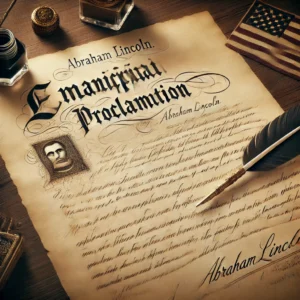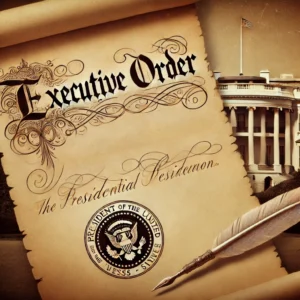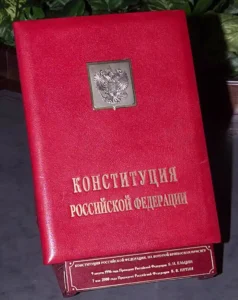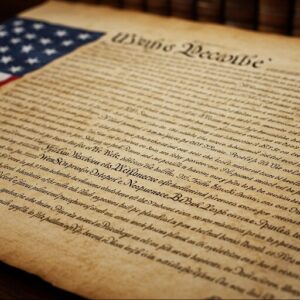The US Constitution
The importance of the Constitution to the American way of life
One thing that we hear a lot about lately is the possibility of a Constitutional Crisis. What is that? How does it happen? How likely is it to occur in the near future?
Before answering those questions, we must have an in-depth look at the US Constitution. I am not a constitutional scholar and have no intention of going down that road today. People devote their lives to the study and interpretation of the Constitution. I am just going to discuss what we know about it, where it came from, and how it is relevant to our lives today.
As Americans, we are socialized to believe that the Constitution is sacred, that it is the binding glue that holds our republic together. Amongst the pantheon of American documents, the Constitution stands above all others as an infallible entity.
But is it? Could there be cracks in the sanctity of the US Constitution? Couldn’t we simply change it—add or subtract a few things?
How well the Constitution is engrained into our society
When the President of the United States takes the oath of office, he says these words:
I do solemnly swear (or affirm) that I will faithfully execute the Office of President of the United States, and will to the best of my ability, preserve, protect and defend the Constitution of the United States.
The scope of constitutional protections
Some people who read this oath may note that they have heard the presidents say “So help me God” after repeating this oath. It has often been said that George Washington added this phrase when he took the oath, but the origin of this tradition has been disputed. We do know that Chester A. Arthur used the phrase in 1881 along with many presidents since Arthur, and that the last 17 presidents have all used the phrase. So, do they have to? Could congress pass a law requiring them to say these words? Well…no. Why not? Because Constitutional protections are very broad. In this case, the No Religious Test clause (Article VI, clause 3) does not require a religious oath to hold office. Likewise the Constitution gives the president elect the right to say this phrase (1st Amendment, “Congress will pass no law…abridging the freedom of speech”).
The US military has a similar oath:
I, _____, do solemnly swear (or affirm) that I will support and defend the Constitution of the United States against all enemies, foreign and domestic; that I will bear true faith and allegiance to the same; and that I will obey the orders of the President of the United States and the orders of the officers appointed over me, according to regulations and the Uniform Code of Military Justice. So help me God.
Yes, as of 1861, for officers, and 1962 for enlisted men, the military oath contains the words “So help me God,” but although the rest of the oath must be recited as written, soldiers have the option to opt out of saying “so help me God.”
Regardless of the wording of these oaths, this discussion is just meant to shed light on how deeply the Constitution is imbedded in the social consciousness of Americans. Neither of these oaths specifically ask the president or the military to defend the borders or the nation, or to defend the president or congress. Both oaths only ask that the oath-taker defend the Constitution.
To appreciate how the US Constitution differs from other constitutions around the world, and how these oaths also differ, it might be useful to look at other worldwide constitutions and oaths. For that discussion go here.
The makings of a Constitutional Crisis
So if the Constitution is the binding document of the United States’ system of government, ingrained in our culture and enshrined in these oaths, then what is a Constitutional Crisis?
Put simply, it is a loophole in the Constitution. One of the fundamental functions of the US Constitution is to resolve any conflicts that arise between the three branches of the government. So what happens when one branch appears to be in conflict with another but there is no constitutional mechanism to resolve the conflict? What happens when one branch of the government chooses to ignore constitutional restraints? Or more specifically, when one branch chooses to exploit certain things that are permitted by the Constitution, but were never meant to be used in the way that the branch of the government is using them?
Can a Constitutional Crisis be serious or does the government always work out its differences. Well, yes to the question of if it is serious and no, the conflict is not always peacefully resolved. One such Constitutional Crisis led to the Civil War. Article IV, Section 3, Clause 1 of the US Constitution talks about how new states can be admitted to the Union. But there is nothing in the US Constitution about how states can leave the Union. So when one state wanted to leave the Union and was eventually joined by ten more states, that was a Constitutional Crisis, and it was only resolved by a bloody Civil War.
Incidentally, although the Civil War seemingly ended the debate over secession, it is still an active topic today and remains an unresolved issue in the Constitution. This points out one of several tricky issues that confront a nation held together by a Constitution. The United States was founded via revolution. Indeed, the Declaration of Independence begins with this line: “When in the Course of human events, it becomes necessary for one people to dissolve the political bonds which have connected them with another…”
The founding fathers must have known that to declare otherwise, in the Constitution, might be to disown the very principles of the new nation’s being. It is worth pointing this out here because much of the discussion about the Constitution is centered around the original intent of the founders. Did the founders know that secession was a possibility and then deliberately choose to leave it for future generations to decide? History tells us this didn’t work out well, but history also tells us that that this situation is still not entirely resolved. Another Constitutional Crisis that resolved itself politically and rather benignly was the situation when John Tyler assumed the presidency on the death of William Henry Harrison.
So let’s go back to 1841 and see how this one plays out. William Henry Harrison has just died and John Tyler is his Vice President. Does this mean that Tyler is the president?
The Constitution says this:
In Case of the Removal of the President from Office, or of his Death, Resignation, or Inability to discharge the Powers and Duties of said Office, the Same shall devolve on the Vice President.
So is Tyler THE president? Or is he an acting president who just assumes the president’s duties? In questions not resolved by the Constitution, Tyler assumed the title and function of the presidency. While some believed he was merely the vice president acting as the president, others were unclear if a new election should be held to choose a new president. Of course, it didn’t help Tyler that both of the parties at the time opposed him.
There were three laws eventually passed by Congress that referred to the line of succession, but none of them effectively plugged the gap in the Constitution.
In 1792, a law said that if both the president and vice president were unable to serve then the President Pro tempore of the Senate and then the Speaker of the House would act as president—adopting the same language as the Constitution.
In 1886, a bill substituted cabinet members for members of Congress, in the line of succession.
In 1947, after the death of Franklin Roosevelt, and at the urging of Harry Truman, a succession act restored the Speaker of the House and the Senate pro tempore as second and third in line, behind the vice president, followed by cabinet members. Truman’s notion was that the people who would be first in line should be elected officials.
The reason why there is a fairly exhaustive discussion about this situation, under the heading Constitutional Crisis, is that this situation was handled by legislative band-aids. The solutions seemed equitable and allowed the government to continue functioning without resorting to civil war. But it wasn’t until 1962 that the Constitutional Crisis was finally resolved once-and-for all, with the 25th amendment.
The 25th amendment makes it clear exactly what will happen in this situation:
In case of the removal of the President from office or of his death or resignation, the Vice President shall become President.
This amendment goes even further, and says that:
“Whenever the Vice President and a majority of either the principal officers of the executive departments or of such other body as Congress may by law” transmit a letter to the Speaker of the House and the Senate pro tempore that says the President is unable to serve, then the Vice President will assume the duties of the office as acting president.
Acting president? Isn’t that the same vague language as the original Constitution. In this case, it is cleared up by the language used earlier in this same amendment.
The Polar Extremes of a Constitutional Crisis
The two examples above lay out the polar extremes of a Constitutional Crisis. On the one hand, the crisis could be unresolved and result in civil war or insurrection. On the other end, political solutions can resolve the crisis at least temporarily, until eventually, the Constitution is changed via an amendment.
Oh…so is that the answer? When a constitutional crisis arises, the government just passes an amendment to fix it? Well…no.
Constitutional Amendments
Let’s take a look at the list of amendments: There are 27 of them.
The first 10 were passed right away, the amendments known as the Bill of Rights. A couple adjustments were made in the next couple of years, and then there wasn’t a Constitutional amendment until after the Civil War, in 1865. Between that time – 1865 until 1971, there was a constitutional amendment passed about every 7.5 years. (One final rogue amendment, involving Congressional pay was ratified in 1992 after 208 years. Many of the amendments have time limits for ratification, but this one did not.)
So with amendments changing (or changing back in the case of the 21st amendment to repeal the 18th amendment’s prohibition of alcohol) the Constitution was changed relatively frequently for 100 years. Why is there a pause, if not a full stop?
It’s very hard to have a constitutional amendment passed. In order to become ratified and adopted, an amendment must pass both houses of Congress by a 2/3 majority. And then it must be ratified by ¾ of the states.
We live in a very polarized world. The last time that 2/3 of Congress were of one party was in 1965, and then you’d have to go back to the 1930’s. But can’t there be bi-partisan support? Theoretically, yes, but again, it is currently a very partisan landscape, and the number of cross-over votes are increasingly small. If we take a quick look at the early days of the Republic, the 7th – 17th Congress had enough of one party to make it over this hurdle, but those days are gone. We are now on the 119th Congress.
What about ¾ of the states? It is a bit better in terms of how far back to go, as presidential maps from the 1980’s (about 35 years ago) would show that – at least along party lines – there was enough to make a 75% threshold. Considering that the polarization of America seems to be getting worse in the last 10 years, it does not look like it’ll ever be ripe for a constitutional amendment at least for a generation or two.
The Constitutional Crisis revisited
So what are the stressors on the Constitution? What parts of the Constitution may be stressed to the crisis point or may not work altogether? That begins the next part of this discussion. There are several aspects to examine.
-
- The function of the 3 branches of government, particularly how the Supreme Court interacts with the executive branch.
-
- The extra-Constitutional use of the executive order. Does the use of the executive order ever rise to the level of contravening the Constitution, and if so, what can be done about it?
-
- If one branch of the government chooses to act independently, or controls and manipulates another branch of the government, how would that look and what can be done about it.
Stay tuned. More articles on this subject on the way.




